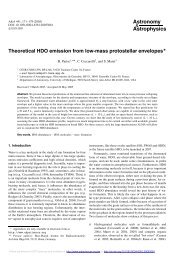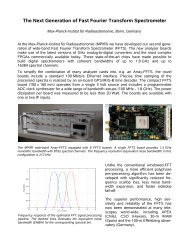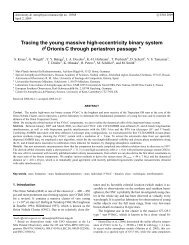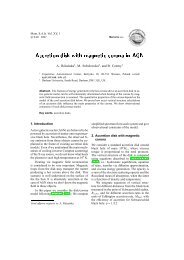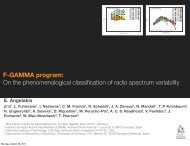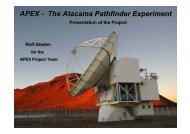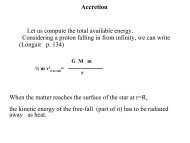First report about the commissioning of the new Effelsberg sub ...
First report about the commissioning of the new Effelsberg sub ...
First report about the commissioning of the new Effelsberg sub ...
Create successful ePaper yourself
Turn your PDF publications into a flip-book with our unique Google optimized e-Paper software.
Chapter 4<br />
Remaining questions<br />
1. Although <strong>the</strong> 9 mm sensitivity has improved a lot, why do <strong>the</strong> o<strong>the</strong>r secondary focus<br />
receivers above 2.8 cm do not show <strong>the</strong> expected increase in sensitivity?<br />
2. Why is <strong>the</strong> sensitivity at 3.6 cm lower than at 2.8 cm? Can <strong>the</strong> 3.6 cm sensitivity be<br />
increased by fur<strong>the</strong>r adjusting ylin.<br />
3. What causes <strong>the</strong> strange increase <strong>of</strong> <strong>the</strong> 6cm gain curve towards elevations below<br />
20 ◦ ?<br />
4. Can <strong>the</strong> position matrix <strong>of</strong> <strong>the</strong> active surface be improved?<br />
5. It was noticed that <strong>the</strong> foci change with <strong>the</strong> active surface being on or <strong>of</strong>f. It should<br />
be tested if we could provide two sets <strong>of</strong> focus constants depending on <strong>the</strong> status <strong>of</strong><br />
<strong>the</strong> active surface.<br />
The first two points might improve by a fur<strong>the</strong>r adjustment <strong>of</strong> <strong>the</strong> <strong>sub</strong>-reflector in ylin<br />
and xrot. Some <strong>of</strong> <strong>the</strong> problems might have been solved during finishing this <strong>report</strong>. J.<br />
Schraml found out that <strong>the</strong> old focus formulas include correction terms for <strong>the</strong> tilt in elevation<br />
that were special for <strong>the</strong> mechanic realisation and <strong>the</strong> geometry <strong>of</strong> old <strong>sub</strong>-reflector<br />
and are not appropriate anymore. Since <strong>the</strong> tilt around one <strong>of</strong> <strong>the</strong> focus axes has still an<br />
effect on <strong>the</strong> primary focus point which has to be aligned with <strong>the</strong> focal point <strong>of</strong> <strong>the</strong> main<br />
dish, corrections are still needed, but <strong>the</strong> formulas have changed. The <strong>new</strong> formulas have<br />
<strong>the</strong> following form:<br />
yrot = F6 · cos(ELV ) (4.1)<br />
−xlin = F1 · cos(ELV ) + F2 − 2055 · sin(yrot) (4.2)<br />
−zlin = F3 · cos(ELV ) + F4 · sin(ELV ) + F5 (4.3)<br />
−2055 · (1 − cos(yrot)) − 2055 · (1 − cos(xrot))<br />
The parameters F1 to F6 for all receivers have been re-measured recently with <strong>the</strong> <strong>new</strong><br />
formulas. The results with <strong>the</strong> <strong>new</strong> focus curves and <strong>the</strong>ir consequences will be presented<br />
in a second <strong>report</strong> (Bach et al. in prep.).<br />
12



